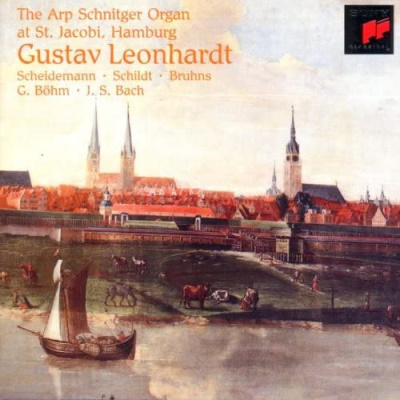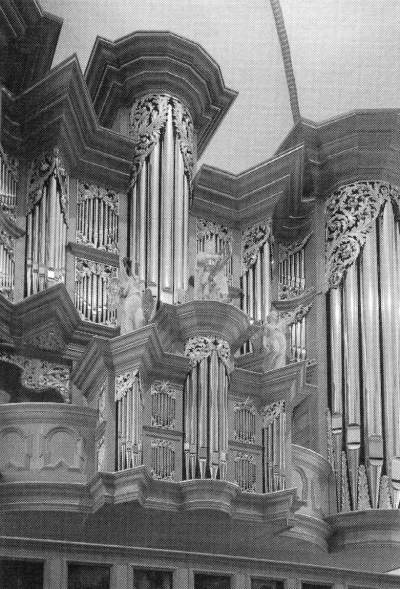 |
1 CD
-SK 66 262 - (p) 1996
|
|
NORTH GERMAN
ORGAN MASTERS - The Arp Schnitger Organ
in the St. Jacobi Church at Hamburg
|
|
|
|
|
|
|
|
| Heinrich
SCHEIDEMANN (c.1595-c.1663)
|
Praeambulum
No. 5 in d |
|
3' 03" |
1 |
|
Praeambulum
No. 4 in d |
|
1' 22" |
2
|
|
Praeambulum No. 3 in D |
|
1' 17" |
3
|
|
Jesu,
du wolltest uns weisen (Intavolation
after a work by Giovanni Giacomo
Gastoldi) |
|
2' 05" |
4 |
|
Benedicam
Domino (Intavolation of a six-voice
motet by Hieronymus Praetorius)
|
|
6' 42" |
5 |
|
In
dich hab ich gehoffer, Herr |
|
6' 08" |
6 |
|
Magnificat
VI. Toni
|
|
17' 03" |
7 |
| Melchior SCHILDT (c.1592-1667) |
Allein
Gott in der Höh sei Ehr |
|
1' 45" |
8 |
| Anonymous
(Netherlands, c.1630) |
3
Variations on Psalm 23 "Mein Hütter undt
mein Hirtt"
|
|
7' 38" |
9 |
| Nicolaus BRUHNS
(1665-1697) |
Praeludium
in e minor (played in d minor)
|
|
5' 01" |
10 |
| Georg BÖHM (1661-1733) |
Gelobet
seist du, Jesu Christ |
|
4' 03" |
11 |
|
Christ
lag in Todesbanden
|
|
5' 04" |
12 |
| Johann Sebastian BACH
(1685-1750) |
Fantasia
and Imitatio in B minor, BWV 563
|
|
4' 54" |
13 |
|
Fantasia
in C minor, BWV Anh. 205 (Anh. II
45) |
|
3' 04" |
14 |
|
Sonata
in A minor, BWV 967 |
|
4' 10" |
15 |
|
|
|
|
|
| Gustav
Leonhardt, Organ - Pitch a' = 494 Hertz
|
|
|
|
|
|
Luogo
e data di registrazione |
|
St. Jacobi Kirche,
Hamburg (Germany) - 18/20
Settembre 1994
|
|
|
Registrazione:
live / studio |
|
studio
|
|
|
Producer /
Recording Supervisor |
|
Wolf Erichson
|
|
|
Recording
Engineer
|
|
Markus Heiland
|
|
|
Tape Editor /
Mastering
|
|
Markus Heiland |
|
|
Prima Edizione
LP |
|
Nessuna
|
|
|
Edizione CD |
|
Sony "Vivarte" | LC
6868 | SK 66 262 | 1 CD - durata
73' 26" | (c) 1996 | DDD
|
|
|
Original Cover
|
|
"View of Hamburg",
1681 by Joachim Luhn
(c.1640-1717).
|
|
|
Note |
|
-
|
|
|
|
|

THE ARP SCHNITGER ORGAN
IN THE ST. JACOBI CHURCH
AT HAMBURG
The first of the Jacobi
Church’s organs to be
described in detail in
contemporary records was
built between 1512 and 1516
by Jacob Iversand and Harmen
Stüven, and was later
enlarged, rebuilt or
repaired by Jacob Scherer
(from 1546), Dirck Hoyer
(1577/78), Hans Bokelmann
(1591), Hans Scherer the
Elder (1588-1592) and
finally by Scherer’s sons
(1605-1607). By this stage
in its history, the
instrument had 53 stops
divided over three manuals
and a pedal. Its
specification is described by
Michael Praetorius in his
“Syntagma musicum”.
The instrument was rebuilt
in 1635 by Gottfried
Fritzsche, who modernized it
along standardized lines,
extending its compass to
four octaves and adding a
further manual and new Rückpositiv.
When Matthias Weckmann
arrived at the Jacobi Church
in 1655, one of his first
acts was to invite
Fritzsche’s nephew, Hans
Christoph, to subject the
organ to a thorough
overhaul. By now the
instrument was becoming
increasingly in need of
repair. In the 1680s the
woodwork was found to be
suffering from live attack,
and so it was decided to
build a new instrument.
The task of building a new
organ was entrusted to Arp
Schnitger, who had already
made a name for himself as
the leading organ builder of
his age with his pioneering
67-stop instrument for the
city‘s Nikolai Church.
Schnitger designed a new
four-manual organ using the
valuable old pipework, which
he skilfully incorporated
into his new 60-stop
instrument. The case,
windchests, bellows, wind
conductors, action and some
35 stops, including all 15
reed stops, were all new and
made, moreover, of the
finest materials. The old
instrument was dismantled in
August 1689, and by Easter
1690 part of the new organ
was already operational,
although it was not until
Easter 1693 that the
instrument was finally
completed. Against the
advice of the organist of
the Katharinen Church,
Johann Adam Reincken, who
acted as consultant, a 32’
Principal was added to the
pedal, thus opening up the
way for a monumental type of
North German instrument that
remains the largest of all
Arp Schnitger‘s surviving
organs.
Few repairs and only a
handful of minor alterations
were undertaken in the
course of the eighteenth
century. New manuals were
installed by Johann Paul
Geycke in 1774/75, a few
adjustments were made and
two new stops were added by
Johann Jakob Lehnert, but
these changes did little to
alter the instrument's
overall character. An even
more cautious spirit
obtained in the nineteenth
century, when the Jacobi
Church organ was spared the
sort of treatment meted out
to comparable instruments,
whereby older stops no
longer in tune with the
times were replaced by new
ones and the instruments
brought into line with
contemporary taste, a
process of alignment that
generally involved the
sacrifice of all the
original materials. The
twentieth century has left
an ambiguous impression:
while two world wars
resulted in the greatest
material losses to the
instrument in the whole of
its lengthy history, this
period also witnessed the
establishment of what has
proved to be the organs
lasting international
reputation. During the First
World War the case pipes
were melted down as part of
the war effort, resulting in
an appalling loss that could
only partially be made good
in the course of the repairs
carried out between 1926 and
1930. Nonetheless, the
Jacobi Church organ became a
symbol of the Organ Revival
of the 1920s. It was Hans
Henny Jahnn who proved the
most eloquent advocate of
its preservation and the
father of its renewed
reputation. At Jahnn‘s
invitation, Günther Ramin,
then the organist at St.
Thomas’s in Leipzig, gave a
series of 24 concerts for
the Ugrino Society, whom he
regaled with a repertory
specially designed to show
off the instrument. The
Jacobi Church organ played a
considerable and
far-reaching role in the
rediscovery of early organ
music and in the way that
that music was interpreted.
The restorations undertaken
by Karl Kemper in 1926 and
1928-1930 were carried out
with particular care, and
for the next twelve years
the restored instrument was
able to lead an untroubled
existence. In 1942 the
church authorities decided
to build a shelter beneath
the church tower in which to
store not only the church’s
artistic treasures but also
the pipes, windchests and
wooden carvings from the
case front, with the result
that all these objects
survived the air raid in
June 1944 that reduced the
church itself to a heap of
rubble.
The rebuilding of the Jacobi
Church organ after the
Second World War - first on
a temporary site in the
south nave and, between 1959
and 1961, in its original
location - proved to be
problematical. Needless
changes were made to the
windchests and pipework and,
in the case of missing parts
such as the case and action,
different measurements were
used, the wrong materials
employed and the whole
reconstruction based on
techniques alien to the
original instrument. Experts
from the world of organ
building were not slow to
voice their criticisms of
the quality of this work,
and although the aura of the
Jacobi Church organ remained
largely unaffected, the
obvious discrepancies
between the immense value of
the surviving original
materials and their
inadequate presentation were
plain for all to see. This
contradiction was not
resolved until the 1980s and
1990s.
The timetable for restoring
the Arp Schnitget organ to
its original state was drawn
up by an international
symposium in 1983; the
church authorities resolved
to proceed with the
restoration in 1984 and duly
appointed a committee of
experts. Between 1985 and
1987 the Dutch organ scholar
Cor H. Edskes documented the
instrument's current state,
and in 1986 the firm of
Jürgen Ahrend of Leer in
East Friesland was
commissioned with the task
of restoring the Jacobi
Church organ. In 1990 work
began on dismantling the
original parts and restoring
them at Leer.
In the meantime, extensive
building work in the church
itself, involving the
renovation of six pillars
and repainting the interior
of the building, meant that
it was finally possible to
remove the huge concrete
gallery erected in 1960 that
had hitherto prevented the
organ from being rebuilt at
its original height. The
concrete gallery was
replaced by a wooden one,
some four metres less deep,
that also takes account of
the requirements for sacred
music at services in the
church. Following completion
of this rebuilding
programme, it was finally
possible to reuse the main
nave of the church for the
first time on Palm Sunday
1992.
During this period the old
pipework was thoroughly
restored at Leer, the
shortened pipes were
lengthened and the
windchests, which had
suffered badly from the
passage of time, were
carefully refurbished. The
wood carvings were similarly
in a poor state of repair -
some had been cut up
completely - and were
restored or remade and then
regilded. The case was
rebuilt in oak on the basis
of old photographs and
contemporary specifications,
as were the bellows, console
and action. New pipes were
made to replace the case
pipes lost in 1917,
including the 32' Principal.
Part of the organ was set up
in the workshop at Leer,
where the pipework was
voiced and tuned. The
question of which system of
tuning to adopt is one that
exercised the committee of
experts and church
authorities for some time.
They weighed the importance
of historical fidelity
against the demands that
would be placed on such an
outstanding instrument in
terms of its likely
repertory and decided in
favour of 1/5-comma
mean-tone temperament of a
kind used in Arp Schnitger’s
workshop during the
builder's lifetime. The
chosen temperament involves
relatively pure major thirds
and, as such, is
particularly well suited to
seventeenth-century music,
which achieves a far more
brilliant tone in
consequence. The price that
must be paid for this is a
noticeable harshness in
peripheral keys such as
F-sharp and C-sharp major.
Most of the works included
in the present recording
date from the century when
the organ was built and are
thus ideally suited to it:
Sweelinck and the school
associated with him,
together with those
composers such as Buxtehude,
Bruhns, Böhm and the early
Johann Sebastian Bach who
represent the heyday of the
North German tradition, find
their finest imaginable
advocate in the Jacobi
Church organ.
As a result ofsuch careful
preliminary work, it was
possible to install the
organ in the church within
the space of six weeks in
November and December 1992.
Work on voicing and tuning
was planned for the
following months. The whole
process was completed by
February 1993. On Easter Day
(April 11) 1993, three
hundred years after Arp
Schnitger completed work on
the instrument, the organ
was officially handed over
to the Jacobi Church’s
congregation and to the
wider community of organ
lovers throughout the rest
of the world.
Rudolf
Kelber
Translation
© 1996 Stewart Spencer
|
  |
|
|